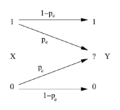| Distribution Name | Probability density function (pdf) | Differential entropy in nats | Support |
|---|
| Uniform |  |  |  |
| Normal |  |  |  |
| Exponential |  |  |  |
| Rayleigh |  |  |  |
| Beta |  for for  |  |  |
| Cauchy |  |  |  |
| Chi |  |  |  |
| Chi-squared |  |  |  |
| Erlang |  |  |  |
| F |  |  |  |
| Gamma |  |  |  |
| Laplace |  |  |  |
| Logistic |  |  |  |
| Lognormal |  |  |  |
| Maxwell–Boltzmann |  |  |  |
| Generalized normal |  |  |  |
| Pareto |  |  |  |
| Student's t |  |  |  |
| Triangular |  |  |  |
| Weibull |  |  |  |
| Multivariate normal |  |  |  |





















































































































